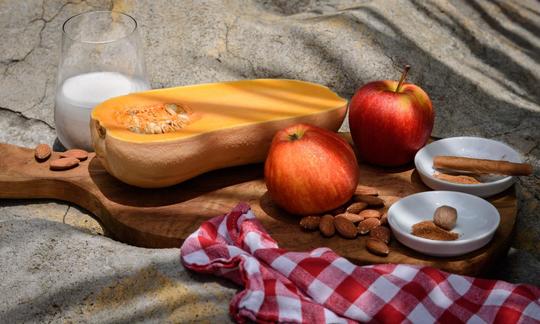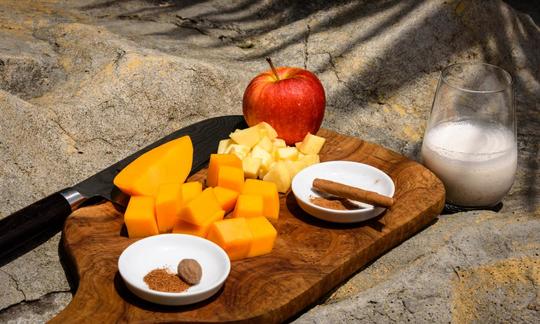Creamy Squash and Apple Soup with Nutmeg and Cinnamon
vegan
Ingredients (for servings, )
| For the creamy squash and apple soup | |
|---|---|
| 240 ml | Drinking water, raw (organic?) (8.4 oz) |
| ½ tsp | Sea salt (raw?, organic?) (0.09 oz) |
| 1 kg | Butternut squash, raw (pear squash), one butternut squash (35 oz) |
| 2 | Apples, raw, without peel (organic?) (11 oz) |
| ½ tsp | Cinnamon (ground, raw, organic?) (0.05 oz) |
| ½ tsp | Nutmeg, ground or grated (raw, organic?) (0.04 oz) |
| 500 ml | Almond milk (raw?, organic?) (17 oz) |
| Serving | |
| 1 dash | Cinnamon (ground, raw, organic?) (0.00 oz) |
Equipment
- blender or hand-held blender / immersion blender
- saucepan or pressure cooker
- vegetable peeler
- stove
Type of preparation
- cook
- chop or grind
- purée
- peel
Preparation
Preparing the soup
Put the tap water (drinking water) and salt in a large saucepan and bring to a boil.To shorten the cooking time, you can use a pressure cooker. After the highest steam pressure is reached, you only need to cook the soup for 3 minutes.
In the meantime, peel and cube the butternut squash. Peel and quarter the apples, remove the cores, and then cut the apple into cubes.
1 kg of butternut squash yields about 550 g (2½ cups) of diced squash.
Add the prepared ingredients and spices to the boiling water. If the ingredients are not entirely covered, add more water. Return to a boil.
Cover the saucepan with a lid, reduce the temperature, and let the soup simmer gently for about 30 minutes, until the butternut squash and apples are tender.
Purée the cooked butternut squash and apple cubes in a blender or food processor (or using an immersion blender directly in the saucepan). Add the almond milk. Purée again until the mixture is smooth.
Author’s note: Never fill a blender more than half full with liquid as it expands. As an added precaution, place a towel over the top of the blender when you are using hot liquids. Similarly, if you are using an immersion blender.
Serving
Sprinkle with a pinch of cinnamon and serve.
|
Nutritional Information per person
Convert per 100g
|
2000 kcal | |
|---|---|---|
| Energy | 108 kcal | 5.4% |
| Fat/Lipids | 2.8 g | 3.9% |
| Saturated Fats | 0.44 g | 2.2% |
| Carbohydrates (inc.dietary fiber) | 21 g | 7.9% |
| Sugars | 15 g | 17.2% |
| Fiber | 4.5 g | 18.2% |
| Protein/Albumin | 3.4 g | 6.8% |
| Cooking Salt (Na:314.0 mg) | 798 mg | 33.2% |
| Essential micronutrients with the highest proportions | per person | 2000 kcal | |
|---|---|---|---|
| Vit | Vitamin C (ascorbic acid) | 51 mg | 64.0% |
| Sodium, Na | 314 mg | 39.0% | |
| Elem | Potassium, K | 669 mg | 33.0% |
| Elem | Phosphorus, P | 225 mg | 32.0% |
| Elem | Calcium, Ca | 229 mg | 29.0% |
| Min | Copper, Cu | 0.28 mg | 28.0% |
| Min | Manganese, Mn | 0.56 mg | 28.0% |
| Vit | Folate, as the active form of folic acid (née vitamin B9 and | 49 µg | 24.0% |
| Vit | Riboflavin (vitamin B2) | 0.30 mg | 21.0% |
| Vit | Vitamin B6 (pyridoxine) | 0.30 mg | 21.0% |
Detailed Nutritional Information per Person for this Recipe
The majority of the nutritional information comes from the USDA (US Department of Agriculture). This means that the information for natural products is often incomplete or only given within broader categories, whereas in most cases products made from these have more complete information displayed.
If we take flaxseed, for example, the important essential amino acid ALA (omega-3) is only included in an overarching category whereas for flaxseed oil ALA is listed specifically. In time, we will be able to change this, but it will require a lot of work. An “i” appears behind ingredients that have been adjusted and an explanation appears when you hover over this symbol.
For Erb Muesli, the original calculations resulted in 48 % of the daily requirement of ALA — but with the correction, we see that the muesli actually covers >100 % of the necessary recommendation for the omega-3 fatty acid ALA. Our goal is to eventually be able to compare the nutritional value of our recipes with those that are used in conventional western lifestyles.
| Essential fatty acids | per person | 2000 kcal |
|---|---|---|
| Alpha-Linolenic acid; ALA; 18:3 omega-3 | 0.12 g | 6.0% |
| Linoleic acid; LA; 18:2 omega-6 | 0.48 g | 5.0% |
| Essential amino acids | per person | 2000 kcal |
|---|---|---|
| Tryptophan (Trp, W) | 0.02 g | 9.0% |
| Isoleucine (Ile, I) | 0.12 g | 9.0% |
| Lysine (Lys, K) | 0.17 g | 9.0% |
| Valine (Val, V) | 0.14 g | 9.0% |
| Threonine (Thr, T) | 0.08 g | 8.0% |
| Leucine (Leu, L) | 0.19 g | 8.0% |
| Phenylalanine (Phe, F) | 0.13 g | 8.0% |
| Methionine (Met, M) | 0.04 g | 4.0% |
| Vitamins | per person | 2000 kcal |
|---|---|---|
| Vitamin C (ascorbic acid) | 51 mg | 64.0% |
| Folate, as the active form of folic acid (née vitamin B9 and | 49 µg | 24.0% |
| Riboflavin (vitamin B2) | 0.30 mg | 21.0% |
| Vitamin B6 (pyridoxine) | 0.30 mg | 21.0% |
| Vitamin E, as a-TEs | 2.5 mg | 21.0% |
| Thiamine (vitamin B1) | 0.15 mg | 13.0% |
| Vitamin K | 8.6 µg | 11.0% |
| Niacin (née vitamin B3) | 1.3 mg | 8.0% |
| Pantothenic acid (vitamin B5) | 0.46 mg | 8.0% |
| Vitamin A, as RAE | 58 µg | 7.0% |
| Biotin (ex vitamin B7, H) | 0.85 µg | 2.0% |
| Essential macroelements (macronutrients) | per person | 2000 kcal |
|---|---|---|
| Sodium, Na | 314 mg | 39.0% |
| Potassium, K | 669 mg | 33.0% |
| Phosphorus, P | 225 mg | 32.0% |
| Calcium, Ca | 229 mg | 29.0% |
| Magnesium, Mg | 63 mg | 17.0% |
| Essential trace elements (micronutrients) | per person | 2000 kcal |
|---|---|---|
| Copper, Cu | 0.28 mg | 28.0% |
| Manganese, Mn | 0.56 mg | 28.0% |
| Iron, Fe | 1.3 mg | 10.0% |
| Zinc, Zn | 0.89 mg | 9.0% |
| Iod, I (Jod, J) | 5.8 µg | 4.0% |
| Fluorine, F | 46 µg | 1.0% |
| Selenium, Se | 0.52 µg | 1.0% |
This creamy squash and apple soup is especially nice during the colder time of year. The apple and cinnamon give the soup a taste of Christmas.
Servings: The author lists 2–4 servings for the amount of ingredients that we have set to serve 4. Decide yourself what serving sizes are best according to your preferences.
Butternut squash: Butternut squash has a relatively thin skin and a fleshy pulp with a buttery, nutty flavor that melts in your mouth. It contains high amounts of beta carotene, which is very good for the skin, hair, and eyes. Just 100 g of butternut squash covers about 80 % of the daily recommended requirement. And it is also rich in vitamin C. Compared to other types of squash, butternut squash contains a relatively high amount of calories, but almost no fat.
Please note that butternut squash can be eaten raw, for example, cut into thin strips or grated in salad or as an ingredient for smoothies.
Almond milk: If you are making your own almond milk, you can use the usual ratio of 1 part almonds to 3 parts water. However, you can also make the milk thinner if you prefer (e.g., 1 to 5). Store-bought almond milk usually contains less than 10% almonds. Almonds are a good source of iron. You can find a link to a recipe for homemade almond milk under “Alternative preparation.”
Using your own almond milk. You can make your own almond milk using our recipe: Raw Almond Milk.
Recommended types of apples: The author recommends using Granny Smith or Honey Crisp apples.
More than a main dish: The apples and cinnamon give this soup a sweet flavor, making it a good choice to serve for breakfast or dessert as well.
Increasing calcium content: If you want to increase the calcium content of the soup, simply use fortified almond milk instead of normal almond milk.
Quicker preparation: To shorten the cooking time, you can use a pressure cooker. After the highest steam pressure is reached, you only need to cook the soup about 3 minutes. Use the quick “cold water release” method (holding the pressure cooker with the lid still on under cold running water). As soon as the pressure is completely removed, carefully take off the lid, but make sure to hold the pressure cooker so that it is pointing away from you.







